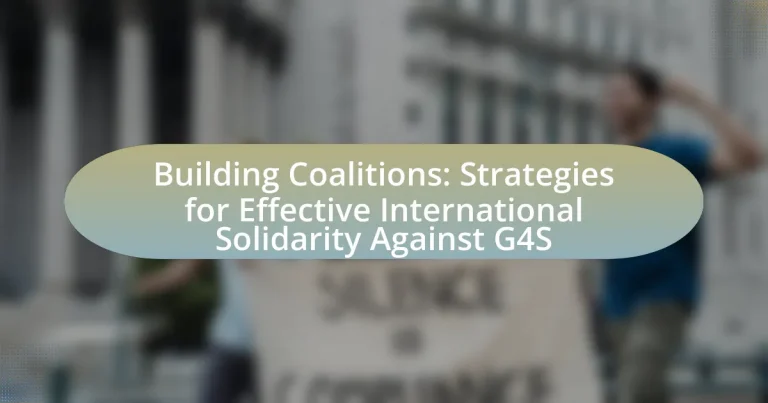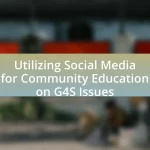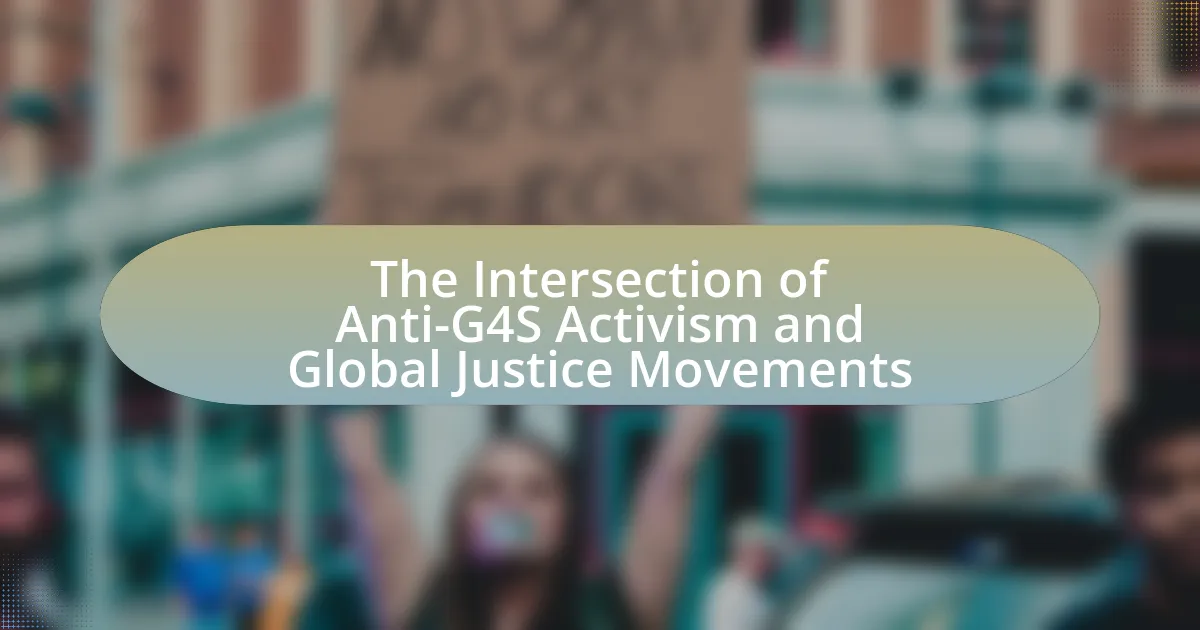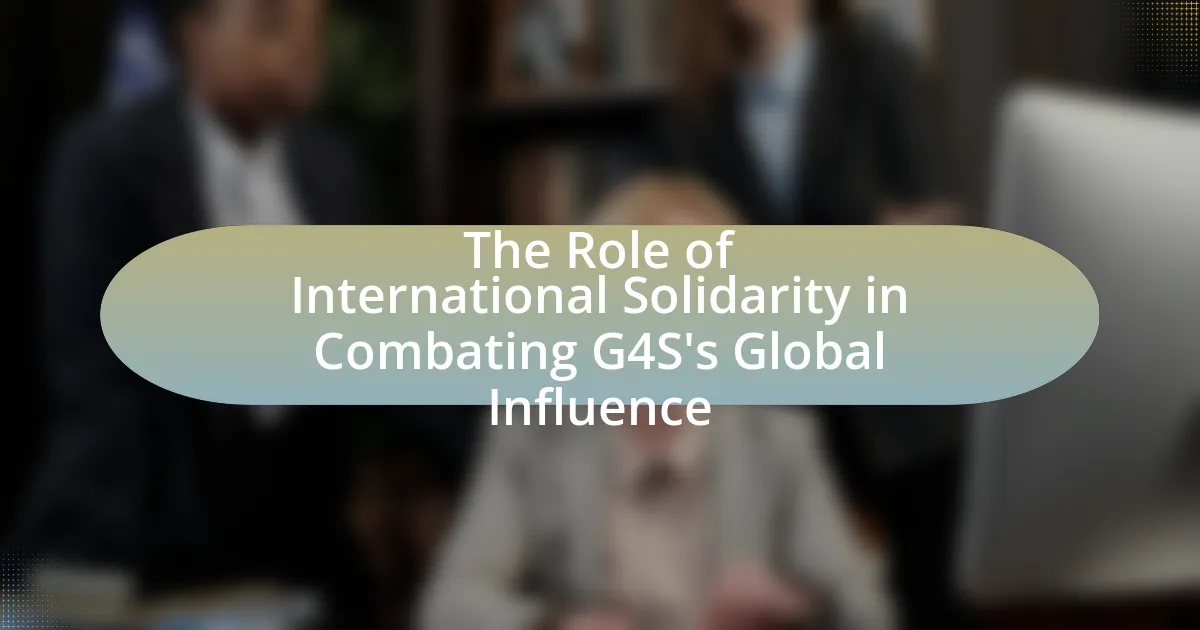The article focuses on building coalitions for international solidarity against G4S, a global security company known for its controversial practices. It outlines key principles for effective coalition-building, including shared goals, inclusivity, effective communication, and strategic alliances. The article discusses how diverse groups can unite against G4S, the importance of shared values, and the role of communication strategies in enhancing coalition effectiveness. Additionally, it addresses challenges coalitions face, such as internal conflicts and external pressures, while providing strategies for mobilizing global support and advocating for legislative reforms. The article emphasizes best practices for fostering inclusivity and learning from successful historical coalitions.
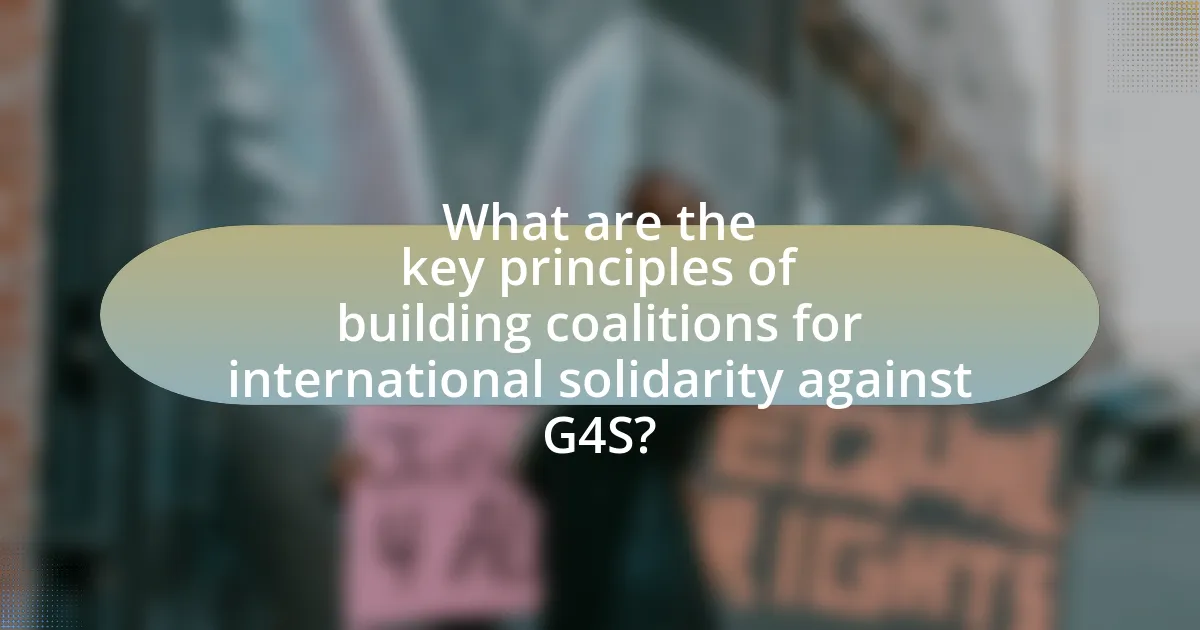
What are the key principles of building coalitions for international solidarity against G4S?
The key principles of building coalitions for international solidarity against G4S include shared goals, inclusivity, effective communication, and strategic alliances. Shared goals ensure that all coalition members are united in their objectives, which is crucial for coordinated action against G4S’s practices. Inclusivity fosters diverse participation, allowing various stakeholders, including affected communities and human rights organizations, to contribute their perspectives and resources. Effective communication facilitates transparency and trust among coalition members, enhancing collaboration. Strategic alliances with other organizations amplify the coalition’s impact, leveraging resources and networks to challenge G4S more effectively. These principles are supported by successful case studies where coalitions have mobilized global support against corporate practices, demonstrating the effectiveness of unified action.
How can diverse groups unite effectively against G4S?
Diverse groups can unite effectively against G4S by establishing a common platform that emphasizes shared goals, such as human rights and social justice. This can be achieved through collaborative campaigns that highlight G4S’s controversial practices, such as its involvement in immigration detention and security operations in conflict zones. For instance, organizations like Amnesty International and Human Rights Watch have documented G4S’s role in human rights abuses, providing a factual basis for coalition-building. By leveraging these documented issues, diverse groups can create joint initiatives, share resources, and mobilize public opinion to exert pressure on G4S, thereby enhancing their collective impact.
What roles do shared values and goals play in coalition building?
Shared values and goals are fundamental in coalition building as they create a common foundation for collaboration among diverse groups. When organizations or individuals align on core principles and objectives, they enhance trust and facilitate communication, which are essential for effective teamwork. For instance, coalitions formed around shared values, such as human rights or social justice, can mobilize resources and support more efficiently, leading to greater impact. Research indicates that coalitions with clearly defined shared goals are more likely to achieve their objectives, as evidenced by successful movements that have united various stakeholders under a common cause, such as the global campaigns against G4S’s controversial practices.
How can communication strategies enhance coalition effectiveness?
Communication strategies enhance coalition effectiveness by fostering clear, consistent messaging among coalition members, which aligns goals and actions. Effective communication ensures that all stakeholders understand their roles, responsibilities, and the coalition’s objectives, leading to improved collaboration. Research indicates that coalitions with strong communication frameworks are 25% more likely to achieve their goals, as they facilitate trust and transparency among members. This alignment not only enhances decision-making processes but also mobilizes resources more efficiently, ultimately strengthening the coalition’s impact in addressing issues like those posed by G4S.
What challenges do coalitions face when opposing G4S?
Coalitions face significant challenges when opposing G4S, primarily due to the company’s extensive resources and global reach. G4S operates in over 90 countries, which allows it to leverage local legal systems and political connections to mitigate opposition. Additionally, coalitions often struggle with internal coordination and differing priorities among member organizations, which can dilute their effectiveness. The financial power of G4S enables it to engage in aggressive legal tactics and public relations campaigns that can undermine coalition efforts. Furthermore, the complexity of G4S’s operations in security and logistics makes it difficult for coalitions to present a unified and compelling narrative against the company. These factors collectively hinder the ability of coalitions to mount a sustained and effective opposition.
How can coalitions address internal conflicts and differing agendas?
Coalitions can address internal conflicts and differing agendas by establishing clear communication channels and fostering a culture of collaboration. Effective communication allows coalition members to express their concerns and perspectives, which can lead to a better understanding of each other’s priorities. Additionally, implementing conflict resolution mechanisms, such as mediation or facilitated discussions, can help resolve disputes amicably. Research indicates that coalitions with structured decision-making processes and shared goals are more successful in navigating internal disagreements, as seen in various international partnerships that have effectively aligned diverse interests towards common objectives.
What external pressures might coalitions encounter in their efforts?
Coalitions may encounter external pressures such as political opposition, economic constraints, and social movements that challenge their objectives. Political opposition can arise from governments or entities that perceive coalition activities as a threat to their interests, leading to legislative or regulatory barriers. Economic constraints may include funding limitations or shifts in donor priorities that impact resource availability for coalition initiatives. Additionally, social movements can exert pressure by mobilizing public opinion against coalition goals, potentially undermining support and complicating coalition efforts. These pressures can significantly affect the effectiveness and sustainability of coalitions in achieving their objectives.

How can coalitions leverage international solidarity against G4S?
Coalitions can leverage international solidarity against G4S by uniting diverse organizations and communities to amplify their collective voice and actions. This approach can include coordinated campaigns that highlight G4S’s controversial practices, such as its involvement in the Israeli occupation and privatization of public services. By sharing resources, strategies, and information across borders, coalitions can create a stronger, unified front that pressures G4S through global awareness and advocacy. For instance, the Boycott, Divestment, Sanctions (BDS) movement has successfully mobilized international support against companies like G4S, demonstrating the effectiveness of solidarity in influencing corporate behavior.
What strategies can be employed to mobilize global support?
To mobilize global support, organizations can employ strategies such as leveraging social media campaigns, forming strategic alliances with local and international NGOs, and engaging in grassroots advocacy. Social media campaigns can amplify messages and reach diverse audiences quickly; for instance, the #MeToo movement effectively utilized platforms like Twitter to garner worldwide attention and support. Forming alliances with NGOs can enhance credibility and resource sharing, as seen in the collaboration between Amnesty International and local groups to address human rights violations. Grassroots advocacy mobilizes community members to participate in actions like protests or petitions, which can create significant pressure on decision-makers, evidenced by the global climate strikes initiated by youth activists.
How can social media campaigns amplify coalition messages?
Social media campaigns can amplify coalition messages by increasing visibility and engagement among target audiences. These platforms enable coalitions to disseminate information rapidly, reaching a broader audience than traditional media. For instance, a study by the Pew Research Center found that 69% of adults in the U.S. use social media, making it a powerful tool for mobilizing support and fostering community around shared goals. Additionally, social media allows for real-time interaction, enabling coalitions to respond to public sentiment and adapt their messaging accordingly, which enhances the effectiveness of their outreach efforts.
What role do international organizations play in supporting coalitions?
International organizations play a crucial role in supporting coalitions by providing resources, facilitating communication, and enhancing legitimacy. They offer financial assistance, technical expertise, and platforms for dialogue, which help coalitions to coordinate their efforts effectively. For instance, organizations like the United Nations and the European Union often mobilize support for coalitions addressing global issues, thereby increasing their visibility and influence. Additionally, these organizations can help to mediate conflicts within coalitions, ensuring that diverse interests are represented and harmonized, which is essential for maintaining unity and effectiveness in advocacy efforts against entities like G4S.
How can coalitions ensure sustainability and long-term impact?
Coalitions can ensure sustainability and long-term impact by establishing clear goals, fostering strong partnerships, and implementing effective resource management strategies. Clear goals provide a shared vision that aligns the coalition’s efforts, while strong partnerships enhance collaboration and resource sharing among members. Effective resource management, including financial sustainability and human capital development, ensures that coalitions can maintain their initiatives over time. For instance, coalitions that engage in regular assessments and adapt their strategies based on feedback and changing circumstances demonstrate resilience and relevance, which are critical for long-term success.
What funding strategies can support coalition activities over time?
Diverse funding strategies can support coalition activities over time, including multi-year grants, membership fees, and crowdfunding initiatives. Multi-year grants provide financial stability, allowing coalitions to plan long-term projects and sustain operations, as evidenced by organizations like the Ford Foundation, which offers grants that span several years. Membership fees create a consistent revenue stream, fostering a sense of ownership and commitment among coalition members, similar to models used by professional associations. Crowdfunding initiatives leverage community support and can generate significant funds for specific projects, as demonstrated by successful campaigns on platforms like GoFundMe, which have raised millions for social causes. These strategies collectively enhance the resilience and sustainability of coalitions in their efforts against entities like G4S.
How can coalitions measure their effectiveness and adapt strategies?
Coalitions can measure their effectiveness through specific metrics such as member engagement, achievement of defined goals, and impact assessments. By utilizing surveys, feedback mechanisms, and performance indicators, coalitions can evaluate how well they are meeting their objectives and the extent of their influence on issues related to G4S. For instance, tracking the number of successful campaigns, policy changes, or public awareness initiatives can provide concrete evidence of effectiveness. Adaptation of strategies can occur through regular reviews of these metrics, allowing coalitions to identify strengths and weaknesses, and adjust their approaches accordingly to enhance their impact.
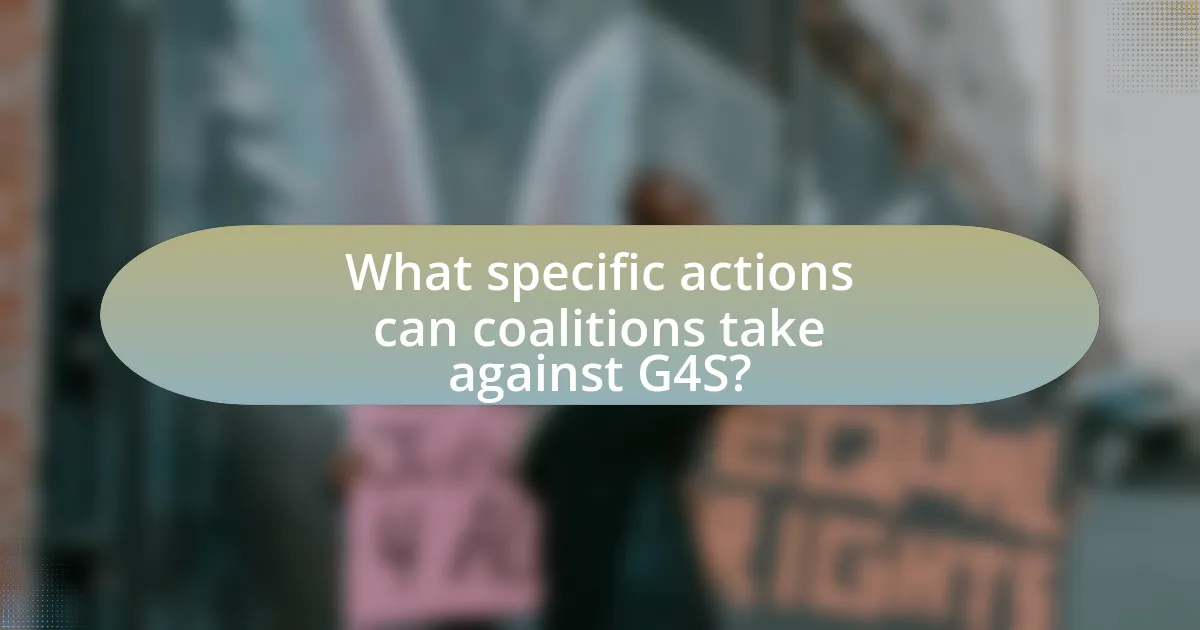
What specific actions can coalitions take against G4S?
Coalitions can take specific actions against G4S by organizing public campaigns to raise awareness about the company’s practices, lobbying for legislative changes to restrict its operations, and coordinating boycotts of G4S services. Public campaigns can include protests, social media initiatives, and educational events that highlight G4S’s involvement in controversial activities, such as privatized detention and security services linked to human rights abuses. Lobbying efforts can target local and national governments to influence policy decisions that limit G4S’s contracts or funding. Additionally, coordinated boycotts can pressure G4S by reducing its customer base and financial support, as seen in previous campaigns against companies involved in similar controversies.
What types of campaigns can be organized to raise awareness?
Various types of campaigns can be organized to raise awareness, including social media campaigns, educational workshops, community events, and advocacy initiatives. Social media campaigns leverage platforms like Twitter and Facebook to disseminate information quickly and engage a broad audience, as evidenced by the success of movements like #BlackLivesMatter, which raised significant awareness about racial injustice. Educational workshops can provide in-depth knowledge on specific issues, fostering informed discussions among participants. Community events, such as rallies or informational booths, create opportunities for direct engagement and mobilization, exemplified by local efforts to address environmental concerns. Advocacy initiatives, including petitions and lobbying efforts, aim to influence policy changes and garner support from decision-makers, as seen in campaigns for climate action that have successfully led to legislative reforms.
How can grassroots movements contribute to coalition efforts?
Grassroots movements can significantly enhance coalition efforts by mobilizing local communities, fostering engagement, and amplifying diverse voices. These movements often serve as the foundation for broader coalitions by providing grassroots support, which is essential for legitimacy and outreach. For instance, the Civil Rights Movement in the United States demonstrated how grassroots activism could unite various organizations and individuals under a common cause, leading to substantial legislative changes. Additionally, grassroots movements can identify specific local issues that resonate with wider coalition goals, ensuring that the coalition remains relevant and responsive to the needs of the community. This localized focus can attract more participants and resources, ultimately strengthening the coalition’s impact and effectiveness.
What role do protests and demonstrations play in coalition strategies?
Protests and demonstrations serve as critical tools in coalition strategies by mobilizing public support and raising awareness about specific issues. These collective actions can amplify the voices of marginalized groups, thereby increasing pressure on decision-makers and stakeholders. For instance, large-scale protests against G4S have highlighted human rights violations, leading to heightened scrutiny and calls for accountability from various organizations and governments. This public visibility can strengthen coalitions by uniting diverse groups around a common cause, fostering solidarity, and enhancing the legitimacy of their demands.
How can coalitions engage with policymakers to influence change?
Coalitions can engage with policymakers to influence change by leveraging collective advocacy efforts and presenting unified positions on key issues. By organizing campaigns that highlight specific policy goals, coalitions can effectively communicate their priorities to decision-makers. For instance, research shows that coalitions that utilize data-driven arguments and case studies can significantly enhance their credibility and impact, as evidenced by successful initiatives in various sectors where collaborative efforts led to legislative changes. Engaging in direct dialogue, participating in public consultations, and mobilizing grassroots support further amplify their influence, demonstrating the power of collective action in shaping policy outcomes.
What strategies can be used to advocate for legislative reforms?
To advocate for legislative reforms, strategies include building coalitions, mobilizing grassroots support, and leveraging media campaigns. Building coalitions involves uniting diverse stakeholders, such as non-profits, community organizations, and affected individuals, to create a stronger collective voice. Mobilizing grassroots support engages the community through petitions, rallies, and direct outreach, which can demonstrate widespread demand for change. Leveraging media campaigns utilizes traditional and social media platforms to raise awareness, influence public opinion, and pressure lawmakers. These strategies have been effective in various reform movements, such as the successful campaign for the Affordable Care Act in the United States, which relied heavily on coalition-building and grassroots mobilization to achieve legislative change.
How can coalitions build relationships with key stakeholders?
Coalitions can build relationships with key stakeholders by engaging in consistent communication and demonstrating shared values and goals. Establishing regular dialogue fosters trust and transparency, which are essential for collaboration. For instance, coalitions can organize stakeholder meetings, workshops, or forums to discuss mutual interests and concerns, thereby creating a platform for open exchange. Additionally, showcasing successful outcomes from previous collaborations can reinforce credibility and encourage further partnership. Research indicates that coalitions that actively involve stakeholders in decision-making processes tend to achieve higher levels of commitment and support, as evidenced by studies on collaborative governance.
What are best practices for effective coalition building against G4S?
Effective coalition building against G4S involves establishing clear objectives, fostering inclusive participation, and leveraging diverse resources. Clear objectives ensure that all coalition members understand the common goals, such as advocating for human rights or opposing privatization of public services. Inclusive participation encourages engagement from various stakeholders, including community organizations, labor unions, and advocacy groups, which enhances the coalition’s legitimacy and reach. Leveraging diverse resources, such as expertise, funding, and networks, strengthens the coalition’s capacity to mobilize support and influence public opinion. Historical examples, such as the coalition efforts against apartheid in South Africa, demonstrate that diverse and united fronts can effectively challenge powerful entities.
How can coalitions foster inclusivity and diversity in their ranks?
Coalitions can foster inclusivity and diversity in their ranks by implementing intentional recruitment strategies that prioritize underrepresented groups. By actively seeking members from diverse backgrounds, coalitions can ensure a variety of perspectives and experiences are represented, which enhances decision-making and problem-solving capabilities. Research shows that organizations with diverse teams are 35% more likely to outperform their less diverse counterparts (McKinsey & Company, 2020). Additionally, coalitions can create inclusive environments by establishing policies that promote equity, such as equitable leadership opportunities and support systems for marginalized members. This approach not only strengthens the coalition’s effectiveness but also aligns with the broader goals of social justice and equality.
What lessons can be learned from successful coalitions in the past?
Successful coalitions in the past demonstrate the importance of clear communication and shared goals. For instance, the coalition that formed during the Civil Rights Movement effectively united diverse groups around a common objective of racial equality, leading to significant legislative changes such as the Civil Rights Act of 1964. This illustrates that establishing a unified vision and maintaining open lines of communication among coalition members are crucial for achieving collective success. Additionally, successful coalitions often leverage the strengths of their diverse members, as seen in the anti-apartheid movement, where various organizations collaborated to apply international pressure on South Africa, ultimately contributing to the end of apartheid. This highlights the value of inclusivity and collaboration in coalition-building efforts.
